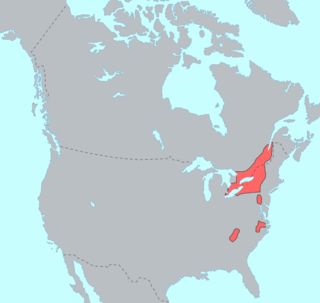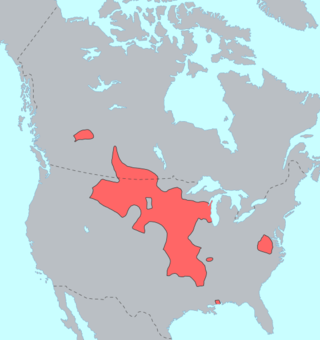Related Research Articles

The Tuscarora are an Indigenous people of the Northeastern Woodlands in Canada and the United States. They are an Iroquoian Native American and First Nations people, based in New York and Ontario.

The Iroquoian languages are a language family of indigenous peoples of North America. They are known for their general lack of labial consonants. The Iroquoian languages are polysynthetic and head-marking.

The Western Siouan languages, also called Siouan proper or simply Siouan, are a large language family native to North America. They are closely related to the Catawban languages, sometimes called Eastern Siouan, and together with them constitute the Siouan (Siouan–Catawban) language family.
The Lumbee are a Native American people primarily centered in Robeson, Hoke, Cumberland, and Scotland counties in North Carolina.
The Waccamaw people were an Indigenous people of the Southeastern Woodlands, who lived in villages along the Waccamaw and Pee Dee rivers in North and South Carolina in the 18th century.

Siouan or Siouan–Catawban is a language family of North America that is located primarily in the Great Plains, Ohio and Mississippi valleys and southeastern North America with a few other languages in the east.

The Haliwa-Saponi Indian Tribe, also the Haliwa-Saponi Tribe, is a state-recognized tribe and nonprofit organization in North Carolina. They are not federally recognized as a Native American tribe.

The Saponi are a Native American tribe historically based in the Piedmont of North Carolina and Virginia. They spoke a Siouan language, related to the languages of the Tutelo, Biloxi, and Ofo.

The Eastern Siouan branch consists of various historical languages spoken by Siouan peoples of the Appalachian Plateau and Piedmont regions of present-day Virginia and the Carolinas. These languages are sometimes collectively referred to as Catawban, Tutelo, Tutelo-Saponi, or Yesah (Yesa:sahį). Eastern Siouan languages were historical spoken by the Monacan Indian Nation, Haliwa-Saponi, Catawba/Iswa, Occaneechi, and Waccamaw peoples. They possibly represent a dialect continuum with Ohio Valley Siouan languages. The Catawban family is a branch of the larger Siouan a.k.a. Siouan–Catawban family.

The Pedee people, also Pee Dee and Peedee, were a historic Native American tribe of the Southeastern United States. Historically, their population has been concentrated in the Piedmont of present-day South Carolina. It is believed that in the 17th and 18th centuries, English colonists named the Pee Dee River and the Pee Dee region of South Carolina for the tribe. Today four state-recognized tribes, one state-recognized group, and several unrecognized groups claim descent from the historic Pedee people. Presently none of these organizations are recognized by the Bureau of Indian Affairs, with the Catawba Indian Nation being the only federally recognized tribe within South Carolina.
The Santee were a historic tribe of Native Americans that once lived in South Carolina within the counties of Clarendon and Orangeburg, along the Santee River. The Santee were a small tribe even during the early eighteenth century and were primarily centered in the area of the present-day town of Santee, South Carolina. Their settlement along the Santee River has since been dammed and is now called Lake Marion. The Santee Indian Organization, a state-recognized tribe within South Carolina claim descent from the historic Santee people but are not presently federally recognized by the Bureau of Indian Affairs.
The Coree were a very small Native American tribe, who once occupied a coastal area south of the Neuse River in southeastern North Carolina in the area now covered by Carteret and Craven counties. Early 20th-century scholars were unsure of what language they spoke, but the coastal areas were mostly populated by Iroquois and Algonquian peoples.

Waccamaw Siouan Indians are one of eight state-recognized tribes in North Carolina. Also known as the Waccamaw Siouan Indian Tribe, they are not federally recognized. They are headquartered in Bolton, in Columbus County, and also have members in Bladen County in southeastern North Carolina.

The Cheraw people, also known as the Saraw or Saura, were a Siouan-speaking tribe of Indigenous people of the Southeastern Woodlands, in the Piedmont area of North Carolina near the Sauratown Mountains, east of Pilot Mountain and north of the Yadkin River. They lived in villages near the Catawba River. Their first European and African contact was with the Hernando De Soto Expedition in 1540. The early explorer John Lawson included them in the larger eastern-Siouan confederacy, which he called "the Esaw Nation."
The Occaneechi are Indigenous peoples of the Northeastern Woodlands whose historical territory was in the Piedmont region of present-day North Carolina and Virginia.
The Wateree were a Native American tribe in the interior of the present-day Carolinas. They probably belonged to the Siouan-Catawba language family. First encountered by the Spanish in 1567 in Western North Carolina, they migrated to the southeast and what developed as South Carolina by 1700, where English colonists noted them.
The Congaree were a historic Indigenous people of the Southeastern Woodlands who once lived within what is now central South Carolina, along the Congaree River.

The Cusabo were a group of American Indian tribes who lived along the coast of the Atlantic Ocean in what is now South Carolina, approximately between present-day Charleston and south to the Savannah River, at the time of European colonization. English colonists often referred to them as one of the Settlement Indians of South Carolina, tribes who "settled" among the colonists.
The Sissipahaw or Haw were a Native American tribe of North Carolina. They are also variously recorded as Saxahapaw, Sauxpa, Sissipahaus, etc. Their settlements were generally located in the vicinity of modern-day Saxapahaw, North Carolina on the Haw River in Alamance County upstream from Cape Fear. They are possibly first recorded by the Spaniard Vendera in the 16th century as the Sauxpa in South Carolina. Their last mention in history is that the tribe joined the Yamasee against the English colonists in the Yamasee War of 1715. Some scholars speculate that they may have been a branch of the Shakori due to being so closely associated with that tribe but others disagree with this assumption.

Tutelo, also known as Tutelo–Saponi, is a member of the Virginian branch of Siouan languages that were originally spoken in what is now Virginia and West Virginia in the United States.
References
- 1 2 Swanton, John Reed (2003). The Indian tribes of North America. Baltimore, MD: Genealogical Pub. Co. pp. 90, 100. ISBN 9780806317304.
- ↑ Lawson, John (1709). “A vocabulary of Woccon”, in A New Voyage to Carolina; Containing the Exact Description and Natural History of That Country: Together with the Present State Thereof. And a Journal of a Thousand Miles, Travel’d Thro’ Several Nations of Indians. Giving a Particular Account of Their Customs, Manners, &c. View online.
- ↑ Carter, R. (1980). "The Woccon Language of North Carolina: Its Genetic Affiliations and Historical Significance", in International Journal of American Linguistics, Volume 46, Number 3. https://www.journals.uchicago.edu/doi/abs/10.1086/465652?journalCode=ijal
- ↑ "Collaboration with the Skarure Woccon to develop the first-ever Woccon Living Dictionary". Living Tongue Institute. 16 October 2021. Retrieved 7 January 2022.
- ↑ "NC Tribal Communities". ncadmin.nc.gov. Retrieved 20 October 2022.
- ↑ "About NC Native Communities". American Indian Center. Retrieved 20 October 2022.
- ↑ "Indian Entities Recognized by and Eligible To Receive Services From the United States Bureau of Indian Affairs". federalregister.gov. Retrieved 20 October 2022.